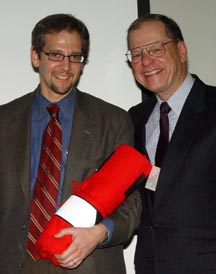OR-Manhattan is launched with powerful approach to public health planning
By David Brand

NEW YORK -- More than a century ago, Cornell offered its first course in industrial engineering. Fifty years ago the Engineering College's School of Operations Research and Industrial Engineering (ORIE) used the emerging digital computer to move beyond industrial engineering to the esoteric new world of operations research.
Now ORIE is moving into yet another era: using advanced algorithms and high-performance computing to solve some of society's very large-scale problems in public health, finance and companies' supply chains. It will do this through collaborations with the public sector and academic institutions, including Weill Cornell Medical College (WCMC).
To bring its skills directly to its potential customers, ORIE has opened a New York City Financial District branch, called Operations Research-Manhattan (or OR-Manhattan), at 55 Broad St. in quarters once occupied by Cornell Theory Center.
The new center was officially launched Dec. 7, before an invited audience of 200 alumni, businessmen, city officials and faculty members, with a talk by one of OR-Manhattan's collaborators in the area of public health and public policy analysis, Dr. Nathaniel Hupert, assistant professor of public health and medicine at WCMC.
Opening the event, Kent Fuchs, dean of the College of Engineering, noted that OR-Manhattan will be providing outreach to Manhattan and the Financial District, to WCMC "and, indeed, to the country." Welcoming a number of Cornell ORIE faculty members to the event, he said, "This is a big investment of faculty time to be here, and this tells you something about this venture."
Introducing OR-Manhattan's director, Jack Muckstadt, the ORIE Acheson-Laibe Professor of Business Management and Leadership Studies, Fuchs said, "It is the vision of Jack Muckstadt and other faculty in deciding to invest in this part of the country, and we are proud of his energy and initiative."
Muckstadt noted that ORIE has pioneered discrete event simulation technology and fundamental optimization techniques. These two areas have already come into play in the school's work with WCMC. In the 1960s, ORIE Ph.D.s helped New York City police and fire departments in resource allocation, which was an early Cornell application of this technology. Today, Muckstadt said, the school is again pioneering in financial engineering education with seminars, courses for credit, a short course, a master's engineering internship program and computational finance.
Hupert's work with OR-Manhattan involves extending a prototype health system response planning model -- the Mass Casualty Response Logistics Program -- that was jointly developed with the new venture's public health and public policy program. (The other two programs are financial engineering and computational financing, and supply chain analysis.) He noted that OR-Manhattan's advanced computing is key to resolving issues in the public health area, from bioterrorism to natural disasters.
Among the questions Cornell's researchers are try to address, he said, is "What is the optimal allocation of patients to hospitals during different types of public health emergencies from flu to earthquakes?"
The model that Hupert and his OR-Manhattan partners are designing will provide logistical support for patient and resource transfer to multiple hospitals for improved public health response to major disasters. Ultimately, this model will be expanded for regional and, potentially, national-level planning. The goal is to create a distributed public health emergency logistics system that would coordinate the work of emergency responders, hospital managers and local and regional officials. It would combine real-time reports from responders in the field with analyses of hospital capacity and resources to show, for example, how 100 burn victims might be optimally distributed between three regional hospitals, or where a ward full of premature infants in intensive care could be moved if a particular hospital needed to be evacuated.
OR-Manhattan, Hupert said, "will be a testing ground for pre-event planning and for deploying a real-time response system."
In developing a model for a "pandemic response," he said, OR-Manhattan's and WCMC's "emerging collaborators for research" will include local emergency response officials, the NewYork-Presbyterian Healthcare System and academic and industry partners, including Lockheed Martin for technical capabilities, Microsoft for data mining and Intel for scalability and modeling.
Replying to a question, he said, "All of the planning we do can alleviate panic by telling the public we have a plan."
Media Contact
Get Cornell news delivered right to your inbox.
Subscribe